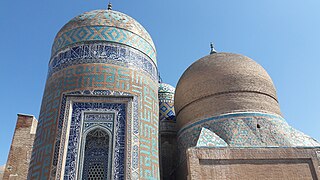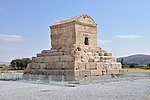
A mausoleum is an external free-standing building constructed as a monument enclosing the interment space or burial chamber of a deceased person or people. A monument without the interment is a cenotaph. A mausoleum may be considered a type of tomb, or the tomb may be considered to be within the mausoleum.

Amol is a city and the administrative center of Amol County, Mazandaran Province, Iran. In the 2006 census, the surveyed population of the city was 197,470, in 55,183 families.

Khorasan-e Razavi Province is a province located in northeastern Iran. Mashhad is the center and capital of the province. Other cities are Quchan, Dargaz, Chenaran, Sarakhs, Fariman, Torbat-e Heydarieh, Torbat-e Jam, Taybad, Khaf, Roshtkhar, Kashmar, Bardaskan, Nishapur, Sabzevar, Gonabad, Kalat. Khorasan-e Razavi is one of the three provinces that were created after the division of Khorasan Province in 2004. In 2014 it was placed in Region 5 with Mashhad as the location of the region's secretariat.

Traditionally, Iranian architects were known as Mi'mars.

Pir Bakran is a city and capital of Pir Bakran District, in Falavarjan County, Isfahan Province, Iran. At the 2006 census, its population was 10,851, in 2,934 families. It is located southwest by road from Isfahan.

Torbat-e Jawm is a city and capital of Torbat-e Jam County, in Khorasan Province, Iran. At the 2016 census, its population was 100,449. Torbat-e Jam is one of the ancient cities of Greater Khorasan.

A mazār is a mausoleum or shrine in some places of the world, typically that of a saint or notable religious leader. Medieval Arabic texts may also use the words mašhad, maqām or ḍarīḥ to denote the same concept. Another synonymous term mostly used in Palestine and in older Western scholarly literature is wali or weli.

Amol County is a county in Mazandaran Province in Iran. The capital of the county is Amol. At the 2006 census, the county's population was 343,747, in 93,194 families. The county is subdivided into three districts: the Central District, Larijan District, and Dabudasht District. The county has five cities: Amol, Rineh, Gazanak, Dabudasht & Amamzadeh Abdallah.

The Imam Reza shrine in Mashhad, Iran is a complex which contains the mausoleum of Imam Reza, the eighth Imam of Twelver Shiites. It is the largest mosque in the world by area. Also contained within the complex are the Goharshad Mosque, a museum, a library, four seminaries, a cemetery, the Razavi University of Islamic Sciences, a dining hall for pilgrims, vast prayer halls, and other buildings.
Marashi is an Arabic-Persian family name indicating ancestry from Ali al-Marash, the grandson of the fourth Shia imam, Ali ibn Husayn, also known as Zayn al-Abidin. The surname is generally associated with a clan of Shi'ite Muslims who are descended from Ali ibn Husayn, who himself was a great-grandson of the Islamic prophet Muhammad. Today, members of the Marashi clan are mostly found in Iran, Iraq, Syria, Kashmir and the UAE.

The Tomb of Cyrus is the monument of Cyrus the Great approximately 1 km southwest of the palaces of Pasargadae. According to Greek sources, it dates back to 559–529 BC. The most extensive description based on a lost account by Aristobulus, who had accompanied Alexander the Great on his eastern campaign in the late 4th century BC, is to be found in the Anabasis of Arrian (6.29). written in the 2nd century AD.

Mir Sayyed Muhammad Marashi, better known by his dynastic name of Suleiman II, was a Safavid pretender who managed to briefly become ruler of some parts of Iran from 1749 to 1750. He was in charge of the affairs of the Imam Reza shrine in Mashhad.

The Tombs of Talpur Mirs are a complex of tombs of the ruling Talpur Mirs of Sindh who reigned from 1784 to 1843. The tombs are also known as Cubbas. These tombs are located in Hirabad, Hyderabad in the Sindh province of Pakistan.

Sheikh Safi al-Din Khānegāh and Shrine Ensemble is the tomb of Sheikh Safi-ad-din Ardabili located in Ardabil, Iran. In 2010, it was registered on the UNESCO World Heritage List. This monument is situated in the Ali-Ghapu area.
Iskandar-i Shaykhi, was ruler of the Afrasiyab dynasty from 1393 to 1403. He was the son and successor of Kiya Afrasiyab.

Qavam al-Din ibn Abdallah al-Marashi, better known as Mir Buzurg or Mir Bozorg, was the founder of the Marashi dynasty, ruling from 1359 to 1362.

Tomb of Ferdowsi is a tomb complex composed of a white marble base, and a decorative edifice erected in honor of the Persian poet Ferdowsi located in Tus, Iran, in Razavi Khorasan province. It was built in the early 1930s, under the Reza Shah, and uses mainly elements of Achaemenid architecture to demonstrate Iran's rich culture and history. The construction of the mausoleum as well as its aesthetic design is a reflection of the cultural, and geo-political status of Iran at the time.

The Tomb of Haydar Amuli or Mir Heydar Amoli Tomb Tower and Monument Seyyed Se Tan is the burial place of Haydar Amuli, the Iranian Mystic and Philosopher. The mausoleum is located in Amol, Iran. Tomb production date, the primary structure was built 6th century AD. The Building brick and octagonal tower and pyramidal dome with height of 12 meters. Two other erudite has been buried here, Izz al-Din Amuli founder mausoleum, himself was a mathematician.
Chartaq, chahartaq (چهارطاق), chartaqi (چارطاقی), or chahartaqi (چهارطاقی), literally meaning "having four arches" in Persian language, is an architectural unit consisted of four barrel vaults and a dome.

The Mashhad of Sayyidah Ruqayyah, also referred to as the Mausoleum or Tomb of Sayyida Ruqayya, is a 12th-century Islamic religious shrine and mosque in Cairo, Egypt. It was erected in 1133 CE as a memorial to as-Sayyidah Ruqayyah, a member of the Prophet Muhammad's family. It is also notable as one of the few and most important Fatimid-era mausoleums preserved in Cairo today.






















